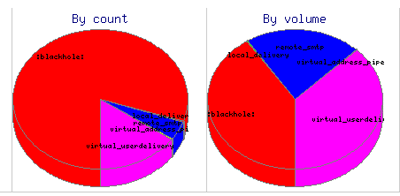Earlier today, I was doing a bit of tweaking and maintenance to the web server I hire from Memset.com. More specifically, I was poking around the Web Host Manager control panel, trying to resolve some email issues for a client whose site and email I host. When I looked at the Mail Delivery Stats (something I had never done before), I was shocked by what I saw: more than 75% of all emails coming into the web server were spam sent to non-existent email addresses!
Take a look at this chart which I downloaded from the Web Host Manager:

The red sections of the charts labelled :blackhole: show the incredible percentage of spam sent to non-existent email addresses.
By way of explanatory note, use of :blackhole: stops all misdirected spam from being delivered. For example, your real email address is j.bloggs@company.com. A spammer sends email to your real email address but also to bloggs@company.com and susie@company.com and company@company.com, etc. Using :blackhole: prevents all those misaddressed emails from being delivered to your inbox.
What really irritates me about the above graphic is that is clearly shows how much wastage and trouble spamming really costs. My server would presumably be more efficient if it were not being hammered by spam.
Liam –
This is interesting. I want to ask you a related, but not exactly direct question. Do you have any idea what the value of spamming is? Who is making money off it? I assume people wouldn’t do it unless it made them money or it is so easy that they don’t even consider it effort. Wouldn’t it make sense to try to make it hard to send or reduce the value, rather than spending money / effort / time on spam blockers?
I don’t know. Just a thought.
Conall
Hi Conall –
As I wrote about in June of last year (in a post entitled ‘Does spam pay?’), people do make lots of money from spamming. The criminals looking for bank details, the charlatan selling sexual performance enhancements and or fake watches and the list goes on. The basic idea is to spread the net of spam wide enough and eventually the spam will catch somebody unknowing or unlucky enough with its scam.
The effort of catching the senders is difficult. Spammers change IP addresses constantly, and lurk in the backwaters of the internet. They are generally very knowledgeable on internet matters and don’t make it easy for police the catch them. From a lay person’s standpoint, it is more realistic to block the spam, than to try to catch the spammer. Catching the spammer is to big a job for an individual or small company.
There is only one solution that could help to really get rid of nearly 90% of spam worldwide: every e-mail sent costs the sender 1ct (or equal). A wide spread e-mail would cost the spammer in total (e.g.): 100000 spam-mails = 1000€. All those bloody suckers with a „spam-home-office“ maybe than think twice before they click on the SEND button.
But: noone will ever succeed with that proposal…
F*** spam